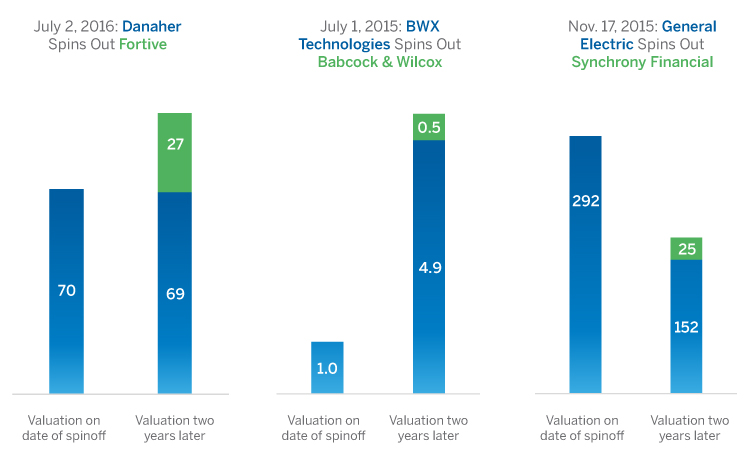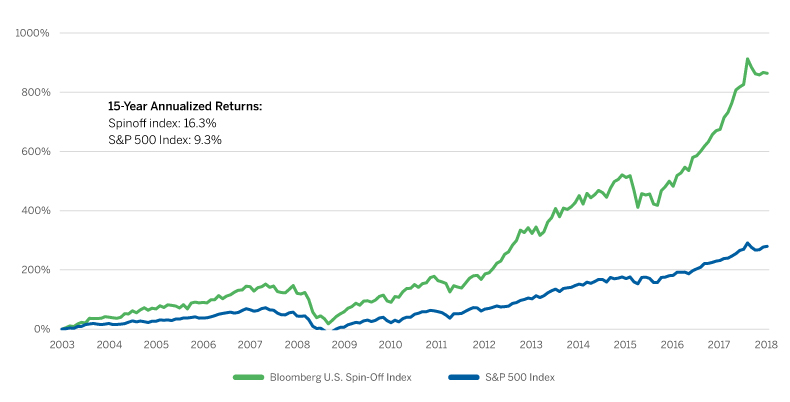The biggest media story in the industrial space this summer has been the accelerating breakup of General Electric. For many decades, GE was the shining example for conglomerates everywhere—Jack Welch’s model of pursuing a #1 or #2 position across many industries was one of the most well-known business strategies in the world. But in recent years, calls for a GE breakup reached a fever pitch, and the company is taking action.
Deconglomeratization—a big word for breaking up or spinning off parts of a conglomerate—is not a new idea. But the pace of spinoff activity has definitely picked up of late. Through July of this year, more than 100 companies have announced spinoff plans, according to Bloomberg—that represents a 54% spike in activity vs. the same period last year and the highest level of activity in at least a decade. So why now? Beyond GE, why has the activist cry for “deconglomeratization” across the industrial sector gained such momentum?
There are several reasons:
-
Too much diversification. In any given quarter, conglomerates typically have a mix of stronger and weaker performers among their business units. Sometimes, the bad offsets the good, so the company struggles to produce exceptional overall results in any given reporting period. In the multiyear bull market we’ve experienced since 2009, shareholders perceive these situations as persistently mediocre.
-
Struggling under their own weight. Sprawling conglomerates inevitably grow more complex over time, leading to inefficiency and paralyzing bureaucracy. Middling stock performance and clunky operations make it difficult for such companies to recruit or retain top talent. Also, the internal competition among business units for funding often leads to capital allocation processes governed more by organizational politics than by business merits.
-
Desire for transparency. Management teams of conglomerates can massage their quarterly earnings reports to fit their preferred narrative, or they can simply decline to provide granular results at the business-unit level. Thus, it is difficult for investors to evaluate individual business units and to hold the managers of those individual businesses accountable for performance. Spinoffs from conglomerates are generally more focused, and offer investors greater transparency while giving management teams a clearer path to unlock the value in their business.
-
Loud voices. We live in an era of shareholder activism, and many big activist investors have been increasingly vocal in calling for conglomerates to break up. Moreover, deconglomeratization has become a popular and desirable narrative for the broader investing public.
- Timing. While we don’t believe this is a primary driver in every situation, the fact remains that we are at a favorable point in the cycle for spinoff activity—valuations are higher, and companies can monetize their assets on good terms (this is especially true for cyclical businesses).
These factors have combined to drive a number of spinoffs in the industrial sector of late, and in many cases these worked out very well for shareholders. For example, Danaher spun out Fortive in 2016. Danaher retained the company’s life sciences, diagnostics, dental, water quality, and product ID segments, while the new Fortive included businesses focused on test and measurement, retail fueling, telematics, and automation. As shown in the chart below, the “unified” Danaher was valued at $70 billion as of this spinoff transaction; the two entities combined were worth nearly $100 billion two years later. (Note that Danaher continues to explore spinoff opportunities; it recently announced its intention to carve out its dental business segment into an independent publicly traded company). In another example, Babcock & Wilcox Enterprises, Inc. spun out its power generation business in 2015. The spinoff retained the Babcock & Wilcox name; the remaining company, BWX Technologies, is a service-focused entity focused on government and nuclear operations. This transaction helped drive more than a 500% return for shareholders over two years.
Recent Spinoffs: Mix of Good and Bad Results (Valuations expressed in $ billions)
However, not all spinoffs are created equal, and investors should not assume that every breakup of a conglomerate will automatically unlock value. Companies have an enormous amount of flexibility to include or exclude nearly anything they want in a spinoff deal—the business being offered may be loaded up with leverage (from the business being spun off as well as from other businesses in the conglomerate’s portfolio), outsized pension liabilities, environmental liabilities and so forth. Truly awful deals are unlikely in today’s market, as a noxious combination of assets would not pass muster with investors, but it is important to understand the pros and cons of a spun-off entity, so you can make an educated judgment as to just how much value the deal can unlock. For example, in 2015 General Electric spun off its credit card business, Synchrony Financial, and while this spinoff was part of a more complex series of transactions surrounding the disposition of GE Capital assets, there is no question that two years later, GE and Synchrony together were valued at a far lower level than GE had been pre-spin.
When it comes to investing in spinoffs, the overall historical data is positive. The Bloomberg Spinoff Index (a market-cap weighted index that adds spun off companies valued at $1 billion or greater at the time of the spinoff transaction, and hold them for three years after the transaction takes place) is one way to track the returns from these companies. As shown in the chart below, this index has outperformed the S&P 500® Index by a wide margin over time. Investors can’t really duplicate the experience of this index, and it is probably not prudent to expect this sort of performance advantage to persist as a universal truth forever. We prefer a more precise approach—in other words, we want to selectively invest in higher-quality spinoffs while avoiding the less attractive ones. As always, we believe that it is essential to understand the underlying business fundamentals of a given company, and the terms of the specific spinoff being contemplated, so we can make educated decisions. We look forward to diving into the research on a variety of proposed industrial spinoffs—from GE and other firms—as more details emerge about them. 
Cumulative Return, 6/30/03-6/30/18:
Bloomberg U.S. Spinoff Index vs. S&P 500 Index
Source: Bloomberg.
The views expressed are those of Brown Advisory as of the date referenced and are subject to change at any time based on market or other conditions. These views are not intended to be and should not be relied upon as investment advice and are not intended to be a forecast of future events or a guarantee of future results. Past performance is not a guarantee of future performance and you may not get back the amount invested.
The information provided in this material is not intended to be and should not be considered to be a recommendation or suggestion to engage in or refrain from a particular course of action or to make or hold a particular investment or pursue a particular investment strategy, including whether or not to buy, sell, or hold any of the securities or asset classes mentioned. It should not be assumed that investments in such securities or asset classes have been or will be profitable. To the extent specific securities are mentioned, they have been selected by the author on an objective basis to illustrate views expressed in the commentary and do not represent all of the securities purchased, sold or recommended for advisory clients. The information contained herein has been prepared from sources believed reliable but is not guaranteed by us as to its timeliness or accuracy, and is not a complete summary or statement of all available data. This piece is intended solely for our clients and prospective clients, is for informational purposes only, and is not individually tailored for or directed to any particular client or prospective client.
The S&P 500® Index represents the large-cap segment of the U.S. equity markets and consists of approximately 500 leading companies in leading industries of the U.S. economy. Criteria evaluated include market capitalization, financial viability, liquidity, public float, sector representation and corporate structure. An index constituent must also be considered a U.S. company. Standard & Poor’s, S&P®, and S&P 500® are registered trademarks of Standard & Poor’s Financial Services LLC (“S&P”), a subsidiary of S&P Global Inc.
The Bloomberg US Spin-Off Index is a modified market-capitalization weighted index that contains equities over USD 1 billion that were spun-off from the US companies. The index includes companies from spin-off, split-off and carved out activities, and does not include the companies offered as tracking stock or in-specie.
BLOOMBERG and BLOOMBERG INDICES are trademarks or service marks of Bloomberg Finance L.P. Bloomberg Finance L.P. and its affiliates ("collectively, "Bloomberg") or Bloomberg's licensors own all proprietary right in the BLOOMBERG INDICES.
BLOOMBERG, BLOOMBERG PROFESSIONAL, BLOOMBERG MARKETS, BLOOMBERG NEWS,BLOOMBERG ANYWHERE, BLOOMBERG TRADEBOOK, BLOOMBERG BONDTRADER, BLOOMBERG TELEVISION, BLOOMBERG RADIO, BLOOMBERG PRESS, BLOOMBERG.COM and BLOOMBERG LAW are trademarks and service marks of Bloomberg Finance L.P., a Delaware limited partnership, or its subsidiaries


